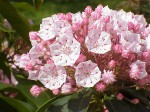 Growing four to twenty feet tall, this evergreen shrub is native to moist woods and clearings, and along streams from southern Maine south to northern Florida, and west to Indiana and Louisiana. It is a member of the heather family, Ericaceae, that also includes blueberries, cranberries, and rhododendrons. The leathery glossy green leaves are up to five inches long, and are dark green above, yellow green below. The flowers appear in terminal clusters six inches across in late spring to early summer and range in color from rose-pink to white with purple markings. They are cup-shaped, one inch across, and give way to showy brown fruits that persist into winter. When grown in sufficient light, the bush is dense but if given insufficient light can become open and unattractive. This shrub naturalizes well and can be used in a foundation planting, partially shaded area, shrub border, or mixed border where it provides a good backdrop for annuals and perennials.
Growing four to twenty feet tall, this evergreen shrub is native to moist woods and clearings, and along streams from southern Maine south to northern Florida, and west to Indiana and Louisiana. It is a member of the heather family, Ericaceae, that also includes blueberries, cranberries, and rhododendrons. The leathery glossy green leaves are up to five inches long, and are dark green above, yellow green below. The flowers appear in terminal clusters six inches across in late spring to early summer and range in color from rose-pink to white with purple markings. They are cup-shaped, one inch across, and give way to showy brown fruits that persist into winter. When grown in sufficient light, the bush is dense but if given insufficient light can become open and unattractive. This shrub naturalizes well and can be used in a foundation planting, partially shaded area, shrub border, or mixed border where it provides a good backdrop for annuals and perennials.
Type: Broadleaf evergreen shrub.
Outstanding Feature: Clusters of flowers in spring; evergreen foliage.
Form: Haystacked to round.
Growth Rate: Slow.
Bloom: Clusters of cup- or bowl-shaped red/pink to white flowers in late spring to early summer.
Size: 4-20’ H x 4-20’ W.
Light: Full sun in North where soil is moist; morning sun and afternoon shade in South.
Soil: Cool, moist but well drained, organic, acidic.
Hardiness: Zones 5-9.
Care: Avoid high amounts of fertilizer.
Pests and Diseases: lacebug; leaf spot in shade; susceptible to scale and weevils.
Propagation: Seed; softwood cuttings in spring or semi-ripe cuttings in summer; layering in summer.
Outstanding Selections: Many cultivars have been produced that offer variations in size, color, and resistance to leaf spot. Some examples:
‘Bridesmaid’
-
- (Dark pink buds open to white dinner plate- shaped flowers; disease resistant; low and spreading)
‘Elf’
-
- (pink buds, white blooms; 3’ tall)
‘Olympic Fire’
- (Red buds open to pink; disease resistant)
Companions: Azaleas, rhododendrons, winter creeper (Euonymus fortunei ‘Silver Queen’), Andromeda ( Pieris spp.), and other broadleaved evergreen shrubs.
Comments: Foliage is poisonous to livestock.
